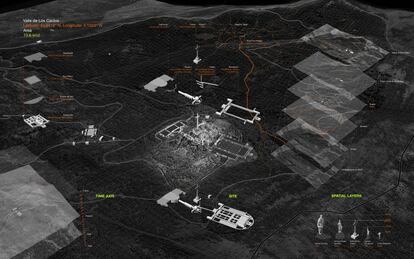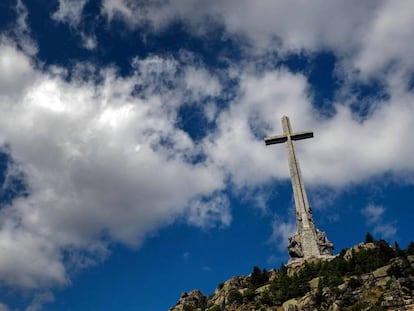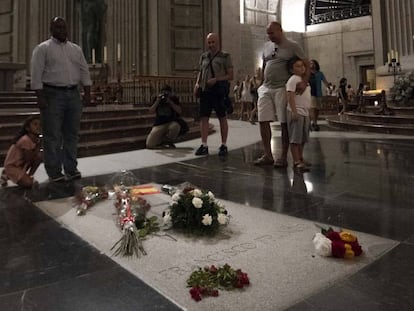An international project to re-think the burial site of former dictator Franco
‘Deep Space,’ presented at the Goethe Institut in Madrid, uses virtual reality to change the totalitarian nature of Civil War monument the Valley of the Fallen

The Spanish Supreme Court’s decision this week to temporarily halt the exhumation of Francisco Franco’s remains came a day before the Goethe Institut in Madrid presented an international project to “re-think” the Valley of the Fallen, the controversial Civil War monument and burial site of the former dictator, located around 50 kilometers outside the capital.
The Deep Space project is the brainchild of an international think tank called Hybrid Space Lab, which is made up of artists, archeologists, anthropologists, scientists, psychologists, architects, designers, historians, landscape artists and law experts, among others.
The project plays with “augmented reality” to create a new environment that merges real and virtual worlds
Their goal: “to transform and re-signify the Valley of the Fallen.” The task could prove as difficult as moving Franco’s remains from the Valley to Mingorrubio-El Pardo cemetery, as the administration of acting Prime Minister Pedro Sánchez, of the Socialist Party (PSOE), has been trying to do for the better part of a year.
The project came to life after the Spanish government approved a decree to exhume Franco’s remains in August of last year.
“What transformations are still needed at the Valley of the Fallen so as not to create a cenotaph – an empty burial monument?” ask the promoters of the project on their website.
The conclusions of the multidisciplinary working group were presented on Wednesday at the Goethe Institut, which is also hosting a photo exhibition by Miquel González about the lingering traces of Francoism.

Experts feel that the wounds are still open because the real story of how the monument was built has not been made public. “There is no information about the prisoners of war who were forced to work at the site, or their families, who lived in barracks near the grounds,” say the professors Elizabeth Sikiaridi and Frans Vogelaar, who set up the project. “Informing about the monument from the point of view of the victims sheds a completely different light, and it is therefore essential for its signification.”
There is no information about the prisoners of war who were forced to work at the site
Project founders Elizabeth Sikiaridi and Frans Vogelaar
Deep Space proposes two lines of action: digital and physical. The first one incorporated “marginalized voices” in the reconstruction of a new monument that includes more than “the totalitarian narrative of the site.” The reconstruction of memory has to be decentralized and democratized through these alternative voices, say these experts.
The project plays with “augmented reality” to create a new environment that merges real and virtual worlds. This could expand the geographical boundaries of the Valley to include the archeological remains of the barracks where the war prisoners lived during construction.
Deep Space also suggests creating a Center for Civil War Research and a Global Center for Peace and Interpretation inside the site’s buildings by the year 2068. But the community of Benedictine monks who still live there would have to go. As for the 120-meter cross overlooking the site, Sikiaridi and Vogelaa do not feel it has to be torn down. “Art can open up new perspectives and support reconciliation.”
English version by Susana Urra.
Tu suscripción se está usando en otro dispositivo
¿Quieres añadir otro usuario a tu suscripción?
Si continúas leyendo en este dispositivo, no se podrá leer en el otro.
FlechaTu suscripción se está usando en otro dispositivo y solo puedes acceder a EL PAÍS desde un dispositivo a la vez.
Si quieres compartir tu cuenta, cambia tu suscripción a la modalidad Premium, así podrás añadir otro usuario. Cada uno accederá con su propia cuenta de email, lo que os permitirá personalizar vuestra experiencia en EL PAÍS.
¿Tienes una suscripción de empresa? Accede aquí para contratar más cuentas.
En el caso de no saber quién está usando tu cuenta, te recomendamos cambiar tu contraseña aquí.
Si decides continuar compartiendo tu cuenta, este mensaje se mostrará en tu dispositivo y en el de la otra persona que está usando tu cuenta de forma indefinida, afectando a tu experiencia de lectura. Puedes consultar aquí los términos y condiciones de la suscripción digital.
More information
Archived In
Últimas noticias
Most viewed
- Sinaloa Cartel war is taking its toll on Los Chapitos
- Oona Chaplin: ‘I told James Cameron that I was living in a treehouse and starting a permaculture project with a friend’
- Reinhard Genzel, Nobel laureate in physics: ‘One-minute videos will never give you the truth’
- Why the price of coffee has skyrocketed: from Brazilian plantations to specialty coffee houses
- Silver prices are going crazy: This is what’s fueling the rally










































